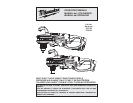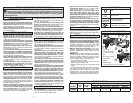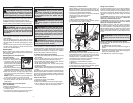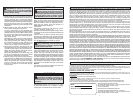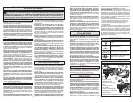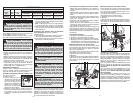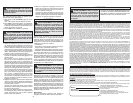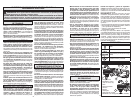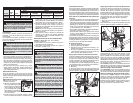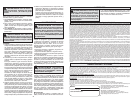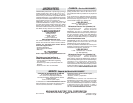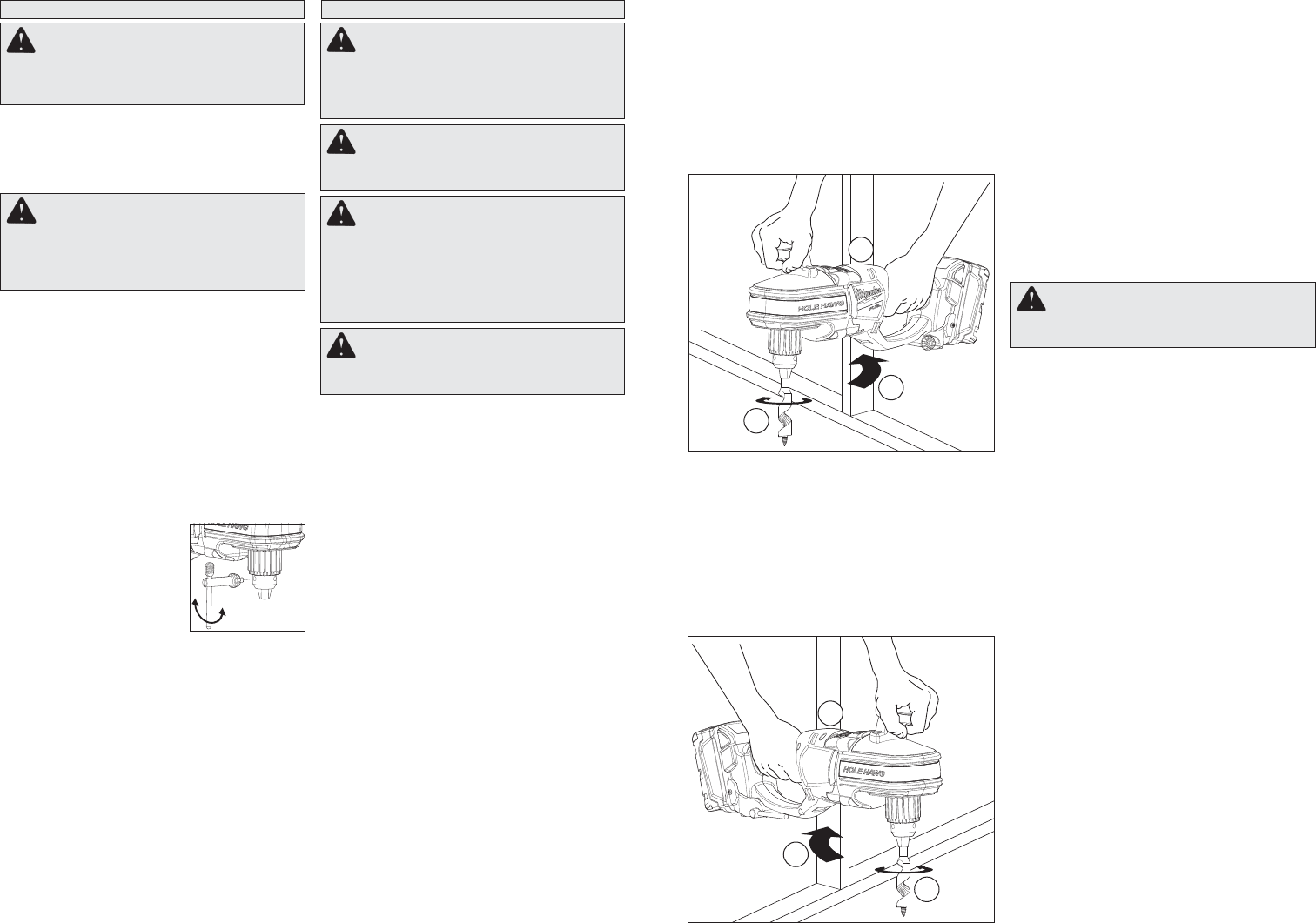
4
5
ASSEMBLY
WARNING Recharge only with the
charger specifi ed for the battery. For specifi c
charging instructions, read the operator’s
manual supplied with your charger and battery.
Inserting/Removing the Battery
To remove the battery, push in the release buttons
and pull the battery pack away from the tool.
To insert the battery, slide the pack into the body of
the tool. Make sure it latches securely into place.
OPERATION
WARNING Always remove battery
pack before changing or removing acces-
sories. Only use accessories specifically
recommended for this tool. Others may be
hazardous.
Bit Selection
• Use sharp bits. Sharp bits are less likely to bind
when drilling.
• Use the proper bit for the job. There are many
types of bits designed for specifi c purposes. Check
the information on the bit's packaging for proper
usage.
• Do not use bits larger than the rated capacity of
the drill. Gear damage or motor overload may
result (see "Specifi cations").
Installing Bits
Always remove the battery before inserting or
removing bits. Select the proper style and size bit
for the application.
Installing Bits into Keyed Chucks
(Cat. No 2707-20)
1. Remove the battery pack.
2. Open the chuck jaws wide
enough to insert the bit. Be
sure the bit shank and chuck
jaws are clean. Dirt particles
may prevent the bit from lin-
ing up properly.
3. Insert the bit into the chuck. Center the bit in the
chuck jaws and lift it about 1/16" off of the bottom.
Tighten the chuck jaws by hand to align the bit.
4. Place the chuck key in each of the three holes
in the chuck, turning it clockwise to tighten the
chuck securely.
NOTE: Never use a wrench or means other than
a chuck key to tighten or loosen the chuck.
5. To remove the bit, insert the chuck key into
one of the holes in the chuck and turn it coun-
terclockwise.
Installing Bits into 7/16" Hex Chuck
(Cat. No 2708-20)
1. Remove the battery pack.
2. To attach an accessory, press the shank into the
hex drive chuck.
3. To remove the accessory, pull out the ring and
remove the accessory. Release the ring.
Bit binding
If the bit binds, the drill will suddenly react in the
opposite direction of the rotation of the bit. Reduce
the chances of a sudden reaction by following the
instructions listed below. Prepare for a sudden
reaction by holding or bracing securely.
To reduce the chance of bit binding:
• Use sharp bits. Sharp bits are less likely to bind
when drilling.
• Use the proper bit for the job. There are many
types of bits designed for specifi c purposes.
• Keep selfeed bits aligned with the work surface
so bits go in straight (see "Drilling").
• Avoid drilling warped, wet, knotty, and/or pitchy
material if possible.
• Avoid drilling in material that you suspect contains
hidden nails or other things that may cause the bit
to bind.
The direction of reaction is always opposite of the
direction of bit rotation. Reaction is even more likely
to occur when enlarging already existing holes and
at the point when the bit breaks through the other
side of the material.
If the bit does bind:
1. Release the trigger immediately.
2. Reverse the motor.
3. Remove the bit from the work and start again.
4. Do not pull the trigger on and off to attempt to
start a stalled bit. This will damage the drill.
WARNING To reduce the risk of injury,
wear safety goggles or glasses with side
shields.
WARNING To reduce the risk of per-
sonal injury when drilling, hold the tool by isu-
lated gripping surfaces when performing an
operation where the cutting tool may contact
hidden wiring. Contact with a "live" wire will
make exposed metal parts of the tool "live"
and shock the operator
WARNING To reduce the risk of injury,
hold or brace securely. Always be prepared
for bit binding and drill reaction.
WARNING Always remove battery
pack before changing or removing acces-
sories. Only use accessories specifically
recommended for this tool. Others may be
hazardous.
Bracing for forward rotation
When drilling in forward, the bit will rotate in a
clockwise direction. If the bit binds in the hole, the
bit will come to a sudden stop and drill will suddenly
react in a counterclockwise direction.
The following fi gure shows an example of properly
bracing the tool for forward rotation.
A. Forward (clockwise) rotation
B. Reaction
C. Brace drill with motor housing here
If the bit binds, the motor housing braced against
the stud will hold the drill in position.
WARNING To reduce the risk of injury,
keep hands away from the bit and all moving
parts.
Bracing for reverse rotation
When drilling in reverse, the bit will rotate in a coun-
terclockwise direction. If the bit binds in the hole,
the bit will come to a sudden stop and the drill will
suddenly react in a clockwise direction.
The following fi gure shows an example of properly
bracing the tool for reverse rotation.
A. Reverse (counterclockwise) rotation
B. Reaction
C. Brace drill with motor motor housing here
If the bit binds, the motor housing braced against
the stud will hold the drill in position.
Using Control Switch
The control switch may be set to three positions:
forward, reverse and lock. Due to a lockout mecha-
nism, the control switch can only be adjusted when
the trigger is not pulled. Always allow the motor to
come to a complete stop before using the control
switch.
For Forward (clockwise) rotation, push the control
switch from the left side of the tool. Check the
direction of rotation before use.
For Reverse (counterclockwise) rotation, push the
control switch from the right side of the tool. Check
direction of rotation before use.
To Lock the trigger, push the control switch to
the center position. The trigger will not work while
the control switch is in the center locked position.
Always lock the trigger or remove the battery pack
before performing maintenance, changing acces-
sories, storing the tool and any time the tool is not
in use.
Starting, Stopping and Controlling Speed
These tools may be operated at any speed from
0 to full speed.
1. To start the tool, pull the trigger.
NOTE: An LED is turned on when the trigger is
pulled.
2. To vary the driving speed, increase or decrease
pressure on the trigger. The further the trigger is
pulled, the greater the speed.
3. To stop the tool, release the trigger.
A
B
C
A
B
C



